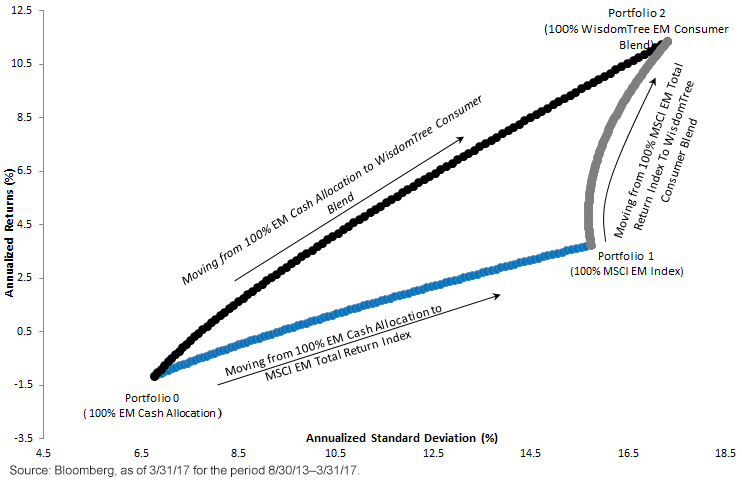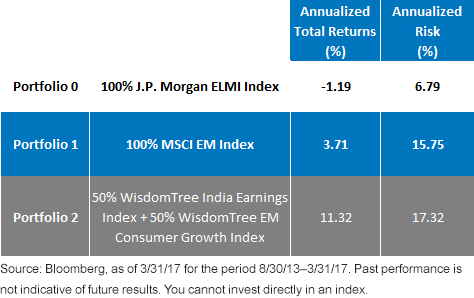Tilting Emerging Market Allocations toward Consumption, Growth & Quality


For a global portfolio, emerging markets (EM) play several important roles. Some investors may invest in EM to diversify their global allocations, while others may be looking for faster growth. This leads to a fundamental question: is a traditional EM exposure enough to capture growth and consumption trends in the developing world?
In this analysis, I propose a powerful combination as a direct play on rising EM consumers: an equally weighted blend of India along with a growth and quality tilt that over-weights the consumer in EM.
Why This Unique Blend of India and Quality Consumers?
Over the last few decades, as global has trade increased, economies and corporate earnings have become significantly integrated, making it harder for investors to look for globally insulated spots. Therefore, a pure EM basket may give exposure to economies whose net trade may be highly integrated with global markets, making the basket as a whole not completely in sync with EM growth. To mitigate this mismatch between EM allocations and EM growth, as a first step, I propose over-weighting EM exposure into economies with high consumption and less external trade.
I previously wrote about how India is largely driven internally, with nearly 60% of its gross domestic product (GDP) from household consumption. This is more than 1.5 times that of India’s northern neighbor, China.1 When we combine these high consumption numbers along with India’s demographics, its rising middle class and its projected GDP numbers from the IMF, we have the world’s largest growing, accessible economy that is internally driven, with consumption as its fundamental driver.
In addition, India has been making giant strides to improve its economy and make its markets efficient through a host of reforms and incentives. This makes Indian equities a key component of our blend for consumption as well as growth of EM.
Next, as a further over-weight in growth-oriented consumption, I propose investing in EM with an over-weight in consumer sectors but with a strong bias for growth and quality. The WisdomTree Emerging Markets Consumer Growth Index applies a carefully selected screen for growth, quality and valuations to a basket that is nearly 60% in consumer sectors. This is a targeted exposure to EM companies that are increasing their earnings, have a healthier balance-sheet (quality) and have revenue predominantly coming from within EM.
A blend of India and EM consumer growth provides access to the two key return drivers of what we think of as “true EM allocation”: consumption and growth.
WisdomTree Consumer Portfolios: A Better Risk/Reward Profile than the MSCI Emerging Markets Index
Investors often use the Capital Asset Pricing Model (CAPM) to plot risk/return efficient frontiers. We can use this tool to compare the portfolio described above with a traditional EM index.
In the chart below, every dot is a possible blend of EM allocations. We start from a 100% EM cash allocation (at the bottom left); this is the J.P. Morgan ELMI Index, tracking total returns of local-currency denominated money market instruments in 24 EM countries. Thus, it serves as a starting point equivalent to an EM cash investment. Here, I would highlight the fact that for a U.S. investor, even a cash investment outside the U.S. (i.e., EM in this instance) carries currency risk, leading to a non-zero risk/return. However, being cash, it could be relatively safer than either equities or bonds from those countries.
Traversing the Edges of the EM Efficient Frontier: Where Is My Allocation?
As we travel along the lower edge of this graph, we move from a 100% cash allocation to 100% EM equities through the MSCI Emerging Market Index in increments of 1%. Thus, each dot here is a blend of cash and the MSCI Emerging Markets Index with the right-most dot or Portfolio 1 being 100% MSCI Emerging Markets Index and the leftmost dot or Portfolio 0 being 100% EM cash basket.
The other option is moving along the upper edge or going from a 100% EM cash allocation to 100% WisdomTree Consumer Blend.2 As on the lower edge, every portfolio on the upper edge is also a mix of EM cash and WisdomTree Consumer Blend, with the right-most dot or Portfolio 2 being 100% WisdomTree Consumer Blend and the left-most dot being our Portfolio 0.
Finally, most investors would probably like to be on the right-most edge of this chart, which is all possible mixes of the MSCI Emerging Markets Index and the WisdomTree EM Consumer Blend, with the lowest dot on this edge being 100% MSCI EM and the highest dot being 100% WisdomTree EM Consumer Blend.
Efficient Frontiers for Possible EM Allocations

It is pretty evident from these efficient frontiers that depending on the risk-appetite of an investor, an allocation to WisdomTree Consumer blend (upper edge) had better returns for same level of risk historically.
Thus, the true efficient frontier of optimal portfolios in this EM universe, always made up of our consumer-focused portfolio blended with a cash-like instrument for a given level of risk.
The table below is the actual risk/return on these portfolios.

Conclusion
We believe there remains a strong economic rationale for investing in segments of emerging markets with high consumption and favorable demographics on a forward basis. However, we also notice that, historically, a much better risk/reward profile has been offered by consumer-tilted allocations to EM instead of a vanilla EM exposure.
In my opinion, pockets of EM that offer a combination of consumption, growth and quality companies could significantly improve positioning on the efficient frontier of an EM allocation.
1Source: World Bank, as of 12/31/16.
2The WisdomTree Consumer Blend is an equally weighted blend of the WisdomTree India Earnings Index and the WisdomTree Emerging Markets Consumer Growth Index.
Important Risks Related to this Article
Investments in emerging, offshore or frontier markets are generally less liquid and less efficient than investments in developed markets and are subject to additional risks, such as risks of adverse governmental regulation and intervention or political developments.
Investments focused in India increase the impact of events and developments associated with the region, which can adversely affect performance.


